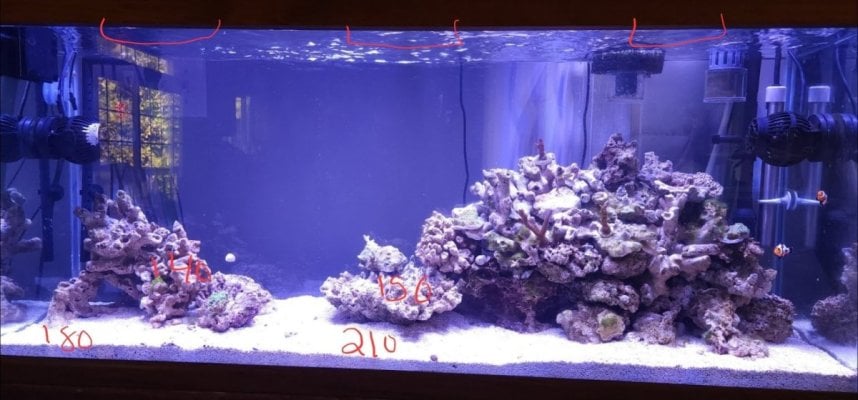Hey everyone! I checked some PAR levels in my tank and got some really weird results. Was hoping others here might be able to help with some sort of explanation.
The tank is a standard 55 gallon aquarium with 3 Hydra 26HD hanging over it evenly spaced across the top as shown in the picture. They are hanging about 13" above the water within a canopy.
I'm less concerned about the relative values as I know I can get higher numbers by lowering hte lights and such. I am, however, perpexed as to why the PAR is about 50 units higher on the sand as opposed to ont he rock adjacent to it. I would expect the values to be either the same or a little stronger on the rock since it's technically higher up in the water column than the sand level. I've marked the PAR readings on the attached picture as well.
The only thing I can figure is reflection from the glass and the sand account for the higher value since the measurements on the sand were taken closer to the glass and hte rock was taken dead center of hte aquarium. Would this be accurate or is something else going on that I'm missing?

The tank is a standard 55 gallon aquarium with 3 Hydra 26HD hanging over it evenly spaced across the top as shown in the picture. They are hanging about 13" above the water within a canopy.
I'm less concerned about the relative values as I know I can get higher numbers by lowering hte lights and such. I am, however, perpexed as to why the PAR is about 50 units higher on the sand as opposed to ont he rock adjacent to it. I would expect the values to be either the same or a little stronger on the rock since it's technically higher up in the water column than the sand level. I've marked the PAR readings on the attached picture as well.
The only thing I can figure is reflection from the glass and the sand account for the higher value since the measurements on the sand were taken closer to the glass and hte rock was taken dead center of hte aquarium. Would this be accurate or is something else going on that I'm missing?




















